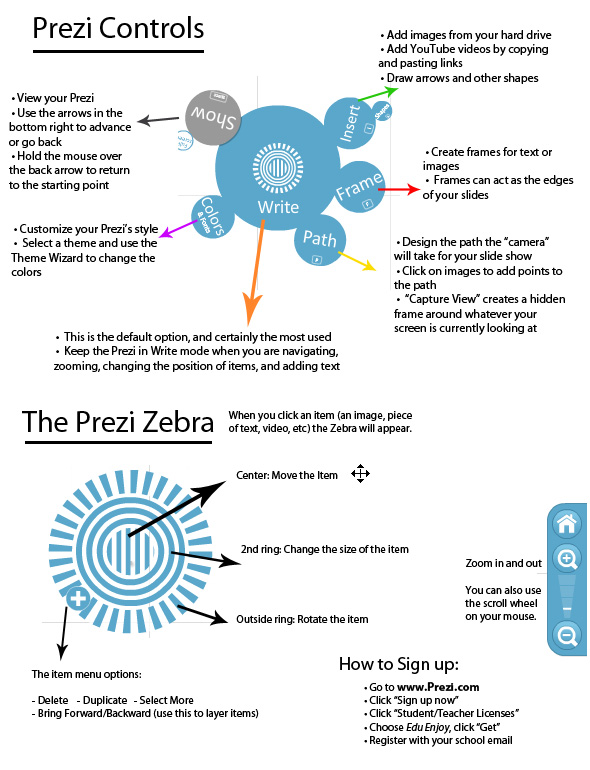Here’s a quick overview of the basic controls for using Prezi.
Category Archives: How-To
Prezi is an online program that allows you to make quick, clean presentations with a variety of transitions and possibilities not seen in Powerpoint. A prezi is basically a big blank digital white board where you can post text, images, and even video clips, and then program a ‘camera’ to pan around the whiteboard, zooming and rotating at defined positions for emphasis. This video explains the basics pretty well:
There is a learning curve with Prezi, but it’s relatively painless. Once you learn the basics and have practiced a bit, you should be able to make a simple Prezi in less than 10 minutes.
Some things to keep in mind:
- Plan your Prezi. Have a general idea of what information you want to include and how your path will look.
- The Transformation Zebra (the blue circular thing) is extremely useful. If you click the center, it lets you move your object, if you click the second ring, it changes the size of the object, and if you click the outer ring, it lets you rotate your object.
- Use the Write tool for most cases, when scrolling around your Prezi and creating new content. If you are on Path or Show when you just want to edit, you will get frustrated.
- Keep it simple. Don’t add really large images. Prezi is web-based, and it will start to act strange if it gets too big.
- YouTube videos can be embedded directly into the Prezi by simply pasting the YouTube link into the text box. As far as I know, they are limited to 360p resolution.
So you have a CWL account and you’re wondering what this eFolio thing is.
How do I get started?
UBC has already set up a very good intro tutorial here.
Why do I have to do this?
The intention of the eFolio is to have you collect ‘artifacts’ and then reflect on them, linking them to eight already defined standards, as determined by the BCTF. The reflections you write demonstrate that what you have learned over the course of the year, and how you’ve grown as an educator.
Secondly, it’s increasingly important in our digital world to be able to use technology such as WordPress’ open-source blogging software. We need to speak in the language of our students, and our students are online. Being able to make a simple blog for posting and collecting homework is becoming an essential skill, and can set you apart from other teachers.
Thirdly, consider this your eResume. The first thing hiring managers do when they receive a resume is Google your name. What do you want them to find?
What is WordPress?
WordPress started as a blogging platform, but has evolved to become a viable Content Management System (CMS). It is very user friendly, and allows you to create web pages, upload media, and write blog posts. Its software is open-source, which means it is completely free.
What do I use posts for?
A post is like a blog post. This is where you will make posts with your Artifacts and Reflections. An example blog post might be called “The Day I Taught My Students Trigonometry”. You could upload a picture of a student doing his or her trigonometry activity (the picture would count as your Artifact) and then you would write your Reflection in the text editor. You need to figure out which Category/Standard to connect your reflection to.
What do I use pages for?
You won’t need to make too many pages, unless you really want to. You could probably get by with just one page, the About Me page. Remember that pages are static, and stay the same unless you edit them directly in the Edit Page area. You cannot select Categories for Pages.
How do I get marked for this?
By the end of the year, you should have a minimum of 8 Artifacts and Reflections, one for each standard/category. Ideally, you would have around 20, and then select your favourite/best ones. You choose your favourite posts by creating Post Tags. Tag a post with the word ‘audit’ to specify that you want it to be marked. Be careful of capitalization. it’s ‘audit’, not ‘Audit’ or ‘AUDIT’.
